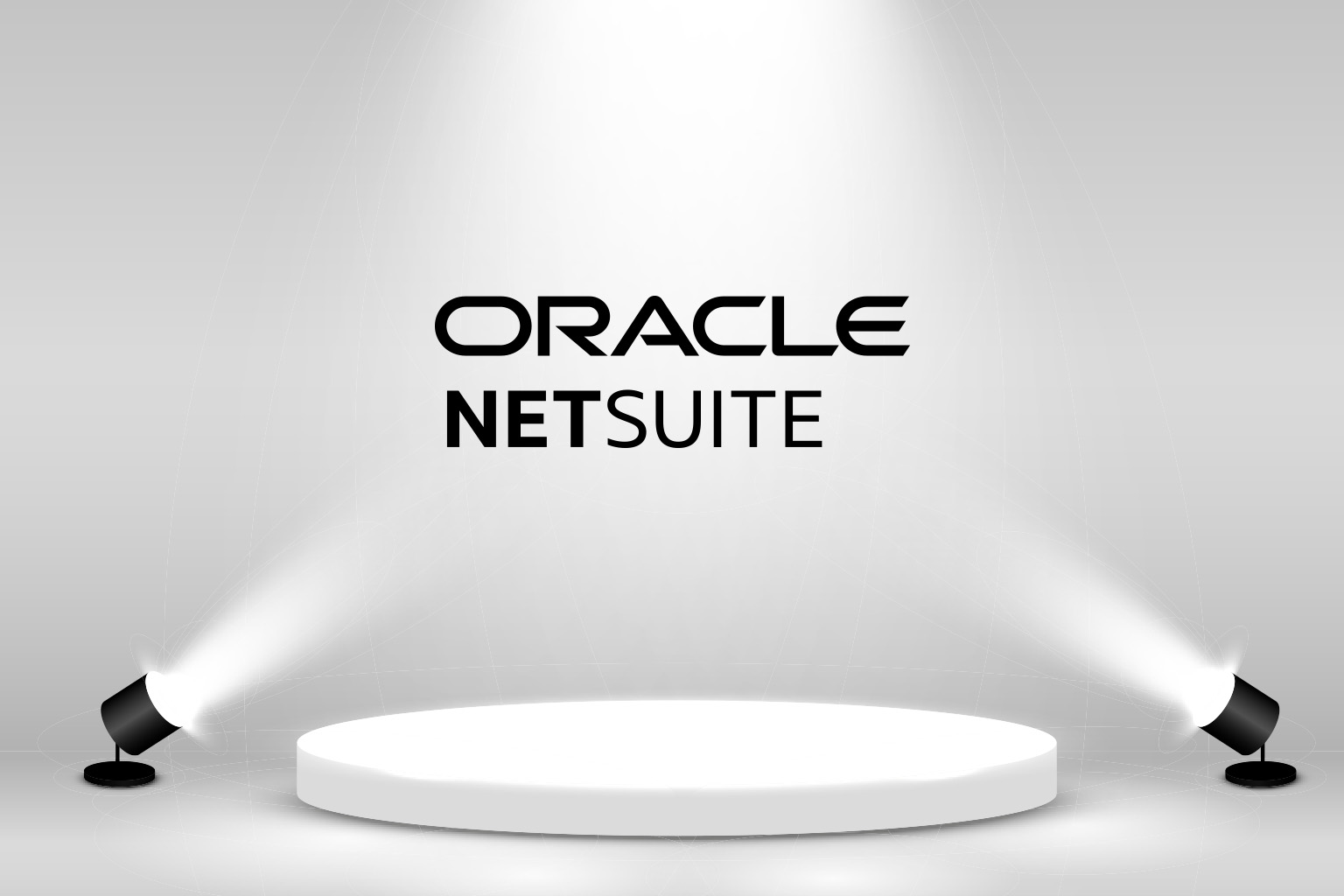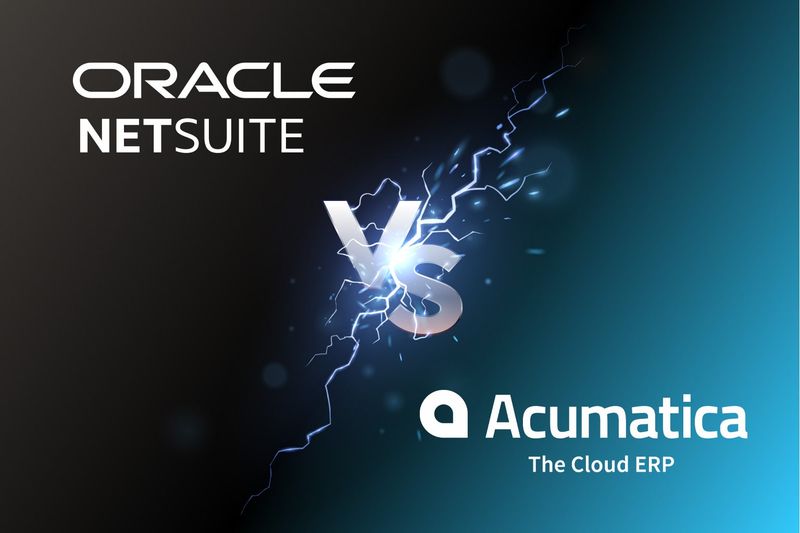Let’s cut to the chase: If you’re looking for an exclusively cloud-based, user-friendly ERP solution powerful enough to transform and predictably scale your business or global enterprise, NetSuite wins over Acumatica as the best ERP solution in the market.
Now let’s uncover why we’ve come to this conclusion by comparing Acumatica and NetSuite side-by-side.
First Things First: What’s an ERP?
Enterprise Resource Planning (ERP) is a software system that integrates various core business processes and functions into a centralized platform, enabling organizations to streamline and manage their operations more effectively.
An ERP provides a unified and real-time view of essential business areas such as finance, human resources, inventory management, supply chain, and customer relationship management.
What’s a Cloud-based ERP?

Cloud-based ERPs are hosted and accessed via the cloud rather than being installed and run on-premises. The software and data are stored on remote servers maintained by a service provider, and users can access the system through an internet connection using almost any computing device (e.g., mobile phones).
With a cloud-based ERP, you can leverage the benefits of ERP functionality without needing extensive and expensive infrastructure and IT resources.
How Long Has NetSuite Been in Business?
NetSuite, officially known as Oracle NetSuite, has been in business since 1998 — celebrating its 25th anniversary in 2023. It was founded by Evan Goldberg and Larry Ellison and initially operated as NetLedger Inc.
In 2016, NetSuite was acquired by Oracle Corporation and became part of the Oracle product portfolio. NetSuite serves over 36,000 businesses of all sizes in 217 countries and territories worldwide.
How Long Has Acumatica Been in Business?
Acumatica Corporation has been in business since 2008 (ten years younger than NetSuite). Serguei Beloussov founded the company and initially operated under the name of Acronis.
In 2010, the company rebranded as Acumatica and shifted its focus to developing cloud-based ERP software solutions.
Acumatica has about 10,000 customers in 50 countries worldwide.
Key Differences Between Acumatica and NetSuite

Diving deeper into the comparison between Acumatica and NetSuite, there are three primary distinctions to factor in: deployment, pricing structures, and target markets.
Let’s explore these differences in detail, providing insights into NetSuite’s unique advantages over Acumatica.
NetSuite Is Exclusively Cloud-Based
One of the most significant differences between Acumatica and NetSuite lies in their deployment options.
Acumatica offers on-premise, private cloud, and SaaS deployment options catering to various business requirements and preferences. This flexibility allows organizations to choose the deployment model that best aligns with their infrastructure, security, and budgetary needs.
On the other hand, NetSuite is exclusively a cloud-based solution. NetSuite’s cloud infrastructure makes is easier to add feature enhancements, tuck in new products, test new releases, and access the software from anywhere at any time. As a result, businesses that prioritize a robust and reliable cloud-based ERP system will find NetSuite to be the more suitable option.
NetSuite Has a More Predictable Pricing Model
Pricing models are another critical factor to consider when comparing Acumatica and NetSuite. Acumatica employs a “pay for what you use” pricing model, which offers flexibility and accessibility for businesses of all sizes. However, this model can confuse organizations uncertain about their exact requirements.
On the other hand, NetSuite offers a per-user pricing model, with costs dependent on factors such as the total user count, add-on modules, and product configuration. NetSuite’s pricing model provides a more predictable pricing setup than Acumatica’s complex model.
NetSuite Serves a Broader Range of Industries
When it comes to the industries served by Acumatica and NetSuite, there are notable differences in their focus and offerings. Acumatica specializes in small retailers and wholesalers, providing fundamental ERP capabilities across financial, customer, and product lines. Its targeted approach allows the solution to cater specifically to the needs of organizations within these sectors.
Conversely, NetSuite caters to a broader range of industries, offering more comprehensive functionality with a simpler user interface. Its versatility and extensive feature set make it a more viable option for organizations operating across various sectors, including:
- Manufacturing
- SaaS
- Retail & Ecommerce
- Distribution
- Construction
Businesses seeking a solution with broader industry applications typically choose Oracle NetSuite.
In-Depth Feature Comparison: NetSuite vs Acumatica

Bottom line: Though NetSuite and Acumatica possess similar feature sets, NetSuite has a deeper, more powerful, more flexible, and wider selection of modules built with growing businesses in mind.
Let’s examine these specific functions offered by each solution, including:
- Financial management
- Inventory management
- CRM
- HCM
- Analytics
- Customizations, Integrations, and APIs
Financial Management Capabilities

Both Acumatica and NetSuite offer robust accounting and financial management tools, including:
- General ledger
- Accounts receivable (AR)
- Accounts payable (AP)
- Cash management
- Currency management
- Tax management
- Recurring revenue management
- Billing
- Fixed assets management
- Payroll management
- Customer dashboards
However, some key differences tip the scale to NetSuite, especially regarding advanced accounting and internationalization.
First, NetSuite provides powerful features like multi-book accounting and a customizable general ledger (and chart of accounts). Suppose you were to incorporate these features into an Acumatica instance. In that case, your choices are customizing Acumatica with the help of an IT vendor or, worse yet, manually processing these functions.
Next, NetSuite is a stronger choice over Acumatica, particularly for international businesses or those planning to expand globally. NetSuite supports transactions and currencies in over 190 and 27 languages and has been used in more than 200 countries.
Acumatica lacks effective localization tools and requires manual currency revaluations. It also doesn’t offer multibook accounting, making it unsuitable for businesses needing to comply with U.S. GAAP and IFRS.
Simply put, NetSuite’s flexible financial and accounting tools handle common tasks easily while tackling more complex functions with ease. With real-time financial data (vs. Acumatica’s slower batch-data processing), NetSuite also comes out on top, providing businesses with faster reports with remarkable precision.
Inventory and Supply Chain Management

Bottom line: NetSuite’s flexible architecture ensures scalability, allowing businesses to add features or customize the system according to their evolving needs.
Both NetSuite and Acumatica boast inventory and supply chain management toolsets, including:
- Data management
- Warehouse management
- Inventory management
- Order/supply/sourcing management
- Transportation management
- Collaboration tools
However, NetSuite also offers the following tools:
- Production management
- Demand planning
- WIP & routing
- Work orders & assemblies
- Shop floor control
- BOM maintenance
Acumatica either provides an entry-level version or does not offer the above out of the box at all.
Plus, NetSuite excels over Acumatica by providing total control and management over fixed assets, including the ability to apply the following depreciation and costing methods easily:
- Straight-Line Depreciation
- Declining Balance Depreciation
- Sum-of-the-Years Digits (SYD)
- Average Cost
- First In, First Out (FIFO)
- Last In, First Out (LIFO)
- Specific Identification
LIFO is not available in Acumatica out of the box.
Customer Relationship Management (CRM)

Bottom line: NetSuite stands above Acumatica’s comprehensive CRM suite, natively integrating into NetSuite ERP and SuiteCommerce.
Both NetSuite and Acumatica CRM include:
- Sales force automation
- Integrated marketing
- Service support automation
- Customer self-service portal
NetSuite offers an additional partner relationship management feature as well.
However, NetSuite CRM working in concert with its financials, SuiteCommerce, and supply chain management tools, differentiates it from Acumatica.
By having data from every touchpoint, from prospect to purchase to customer support, you can deliver targeted and personalized communications at the most granular level — driving engagement and delivering top customer service with beautiful platform-wide automation.
Human Capital Management (HCM)

Bottom line: Businesses prioritizing a seamless, integrated HCM solution will find NetSuite the best option.
NetSuite provides a comprehensive set of core HR features, including employee data management, organizational hierarchy, employee self-service, and document management. It enables businesses to maintain accurate employee records, manage organizational structure, and streamline HR processes. In addition, NetSuite provides:
- Payroll management
- Time and attendance management
- Talent management
- Compensation management
In contrast, Acumatica requires integrations with third-party HCM solutions to augment its core HR capabilities. This may result in additional integration efforts and potential compatibility challenges.
Analytics, Reporting, and Dashboards

Bottom line: NetSuite is a superior solution with real-time data, advanced analytics, and reporting capabilities without additional coding.
Both Acumatica and NetSuite offer advanced reporting, analytics, and customizable dashboards to help businesses gain insights and make data-driven decisions.
Acumatica provides multi-dimensional reporting and analytical capabilities, a business reports designer, templates, ad-hoc filters, and reusable filters for creating personalized reports.
NetSuite’s SuiteAnalytics, on the other hand, comes equipped with built-in key performance indicators (KPIs), searches, and real-time reporting functionalities.
When comparing the customization options between the two solutions, NetSuite allows for granular-level customization with or without coding, while Acumatica’s options are more limited.
Additionally, NetSuite’s database architecture, which houses all data within a single database, enables users to access all information within a single view, saving time and effort compared to Acumatica users.
Customization, Integration, and APIs

Your business has its own needs remarkably different from others, so there’s no room for a cookie-cutter solution. To maximize your ERP, you need the ability to customize your instance to suit your goals and KPIs.
NetSuite’s SuiteCloud stands out as a multi-tenant solution. Constructed on the foundation of JavaScript, it offers an integrated development environment (IDE) and application programming interfaces (APIs) for creating applications within the platform.
Integration is achieved via APIs or through SuiteTalk, a SOAP-based web service platform by NetSuite that allows both cloud-based and on-premise applications to connect directly with NetSuite.
The offering also includes SuiteBuilder, a tool for customizing forms with a simple click, a workflow manager, an Eclipse IDE, and a development framework.
NetSuite customers can further enhance the model through RESTlets, enabling the creation of their own API or Micro Services. They have the freedom to define their own JSON payload and leverage the power of the NetSuite platform (scripting, workflow, search, etc.) to expand the API beyond just SOAP and REST. The REST API also supports queries via SuiteSQL and Workbook datasets.
On the other hand, Acumatica operates on its xRP Cloud Platform, which equally supports REST and SOAP-based web services. It is compatible with the .NET framework, Microsoft’s Visual Studio, C#, and ASP.net.
Implementation

An ERP implementation process is a critical factor to consider, particularly for fast-growing businesses.
NetSuite supplements its implementation teams with the services offered by official NetSuite Solutions Providers specializing in certain regions or industries. This allows customers to implement NetSuite with great care, speed, and specialization.
Acumatica’s implementation process typically takes 6-12 months to go live.
On the other hand, NetSuite’s implementation and support methodology has been refined over two decades of experience, offering a faster and more streamlined implementation process.
Scalability
As for scalability, NetSuite is more suited to rapidly expanding companies, as it can quickly adapt to changing business needs and get organizations up and running in a shorter time frame. Its modular platform is designed to scale as you grow.
While Acumatica may be a viable option for smaller businesses, companies of all sizes seeking a solution with a proven track record of scalability will find NetSuite the better choice.
Final Word: Why NetSuite Wins Over Acumatica

NetSuite offers a more comprehensive feature set across the board and has an impressive pedigree of recorded success to boot. Its focus on cloud-based deployment and per-user pricing model will suit fast-growing companies and those seeking a more predictable, transparent pricing structure.
If you’d like a customized demo, book a call with our NetSuite experts at StratusGreen. We bring a white-glove approach to helping our customers succeed — considering your unique goals and team in everything we do.



